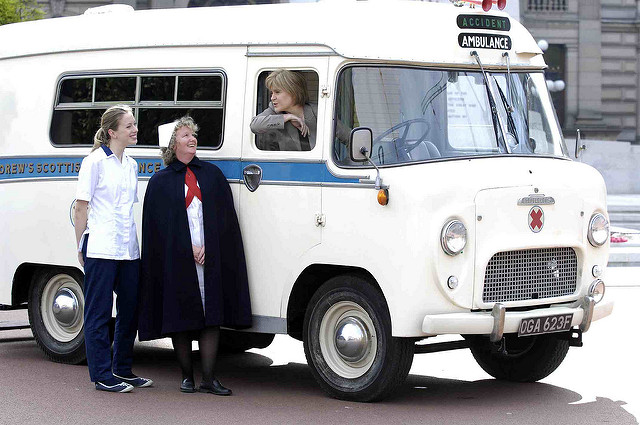The SNP’s radical constitutionalism vs its need to appear as a ‘safe pair of hands’ remains its key strategic dilemma
The SNP won an unprecedented third term in Holyrood, but despite securing more constituency votes than ever before, lost its overall majority. Here, James Mitchell digests the results, and argues that the SNP’s strategic dilemma – simultaneously needing to appear as a safe pair of hands while at the same time proposing a radical new constitutional reality, remains something the party has yet to satisfactorily square.

Which way? (Credit: Scottish Government, CC BY 2.0)
The SNP machine has been quick to point out that the party has just won its (and any party’s) highest ever share of constituency votes. The translation of constituency votes into seats highlights the disproportionality of that element of the system: 46.5% delivered 81% of seats. This compares with the result from last year’s Scottish results in the UK general election when the SNP won 95% of seats with 50% of the vote. But this was not a first-past-the-post election. The SNP advanced in the constituencies but fell back on the lists.
One way of looking at this is that the SNP lost its overall majority by the slimmest of margins in a couple of constituencies. Just 109 votes in Dumbarton and 610 in Edinburgh Central separated the SNP from winning an overall majority.
Alternatively, the SNP’s lost its overall majority because of its relatively poor performance on the list. There are two elements to that relatively. In 2011, there was little seepage between the party’s substantial share of the constituency vote and it share of the list vote resulting in it adding sixteen list seats to its 53 constituencies and giving it an overall majority. Five years on, the SNP was unable to contain the seepage from constituency to list votes and was down on the last election. The party suffered from those who claimed that a list SNP vote was a wasted vote. The SNP fought hard against the perception that this election was already won but it suffered from ‘friendly fire’ from its Yes 45.
The SNP’s ‘Both Votes SNP’ in 2011 worked well but was less successful in this election. The other relatively refers to the fall in SNP list vote since 2011, contrasting with its increase in its constituency vote.
But the really interesting questions relate to who was voting for which party. Throughout the night, commentators were perplexed by the pattern – or rather apparent lack of pattern – to the vote. The SNP was gaining ground in some places, falling back elsewhere. While much of this might be explained in terms of the vagaries of FPTP operating within a multi-party system, the probability is that when we look under the surface we will find patterns that are only barely discernible at the moment.
In our book, Rob Johns and I explain the differences between the two ‘45s ie the 45% who voted SNP in constituencies in 2011 and the 45% Yes vote at the referendum. There was clearly a significant overlap but they were different in more ways than just that the latter 45% was a larger body of voters drawn from a larger voting public. The SNP’s support in recent Holyrood elections has been built on a broader coalition of people who see it as competent, including many who opposed independence, and coming from across the socio-economic spectrum. The YES vote was a larger but, in important ways, a narrower coalition of support. It was more socio-economically coherent. The SNP at last year’s UK general election built on that YES 45 and substantially ate into Labour’s former support.
It was never clear in this election whether the SNP would manage to appeal to both 45s or in what combination. It faced the prospect of losing support amongst its competence 45 if it stressed independence and might lose support from amongst the independence 45 if it focused on governing competence. This was not a problem last year, as nobody expected the SNP to govern the UK but expected it would be able to extract more for Scotland in the event of a coalition which never happened.
In retrospect, it might have been wiser to have unambiguously ruled out a second independence referendum during this Parliament and spiked Ruth Davidson’s guns on that score and focused more on competence. No matter its opponents efforts to portray the SNP as having failed across a range of policy areas, the electorate’s view remained that the governing party was better, and often far better, than any of the others on the alternative. But more importantly, voters do not judge parties like an accountant’s balance sheet but more impressionistically.
The SNP strategy was to try and have its electoral cake and eat it this year and it nearly pulled it off. It faced the dilemma – and one that it will have to face into the future – of building support for its radical constitutional and the need to appear safe and competent. This will be a central dilemma over the next Parliament and beyond.
—
Note: this post originally appeared on the Centre for Constitutional Change. It represents the views of the author and not those of Democratic Audit or the LSE. Please read our comments policy before posting.
—






 Democratic Audit's core funding is provided by the Joseph Rowntree Charitable Trust. Additional funding is provided by the London School of Economics.
Democratic Audit's core funding is provided by the Joseph Rowntree Charitable Trust. Additional funding is provided by the London School of Economics.
The SNP’s radical constitutionalism v its need to appear as a ‘safe pair of hands’ remains its key strategic dilemma https://t.co/TFeMd1YiGm
The SNP’s radical constitutionalism vs its need to appear as a safe pair of hands remains its key strategic dilemma https://t.co/evUyD6Pp1z
SNP’s key dilemma remains the tension between its radical constitutionalism + appearing as a ‘safe pair of hands’. https://t.co/jqsndpWPRf
The SNP’s radical constitutionalism vs its need to appear a ‘safe pair of hands’ remains its key strategic dilemma https://t.co/jqsndpWPRf
The SNP’s radical constitutionalism vs its need to appear as a ‘safe pair of hands’ remains… https://t.co/Wb8Kf3avIT https://t.co/wAZR8OVlE2